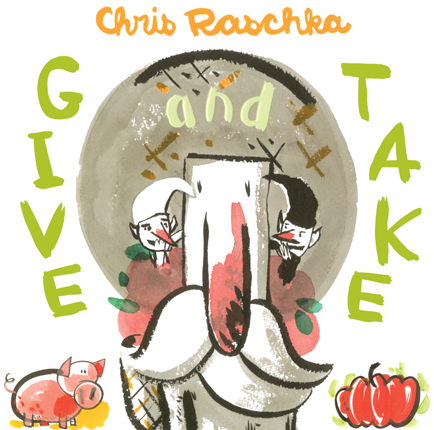Full Text Reviews: Booklist - 06/01/2014 *Starred Review* Meet an apple farmer who loves his apples. One day, he finds the apples of his oldest tree ripe and ready. But while he is picking, someone finds the farmer: an elfin little man named Take. When a grower asks the farmer if he’d like some pumpkins, Take insists the old fellow grab them all. So the farmer dumps the apples and brings home pumpkins instead, winding up with pots of pumpkin soup—and he doesn’t even like pumpkin soup. The next day, another little fellow appears, this one named Give. Give offers the opposite advice and insists that all of the picked apples—along with many opinions—are given to a pig farmer. Finally, the third day sees Give and Take wrestling and squabbling until the farmer trades some of his apples for some of the miller’s flour. The result? Apple pie! And now it is clear (and will be clear to the audience) that what Give and Take need are each other. This simple, powerful parable finds perfect expression in Raschka’s wildly inventive ink-and-watercolor illustrations. Bold, exaggerated swirls depict the action as well as the emotional toll of the farmer’s attempts to balance, well, everything: plans, pronouncements, and produce. Occasionally these dramatic images are a bit hard to decipher, but children will let their imaginations take over as they ponder how give-and-take can work for them. HIGH-DEMAND BACKSTORY: Librarians and fans are always interested in what the multitalented Raschka is up to. Here he makes a welcome foray into the world of fables. - Copyright 2014 Booklist. School Library Journal - 06/01/2014 K-Gr 3—A farmer goes to pick apples in his orchard and encounters a little man named Take, who urges him to take all the pumpkins a neighbor offers. He carries them home and—following his neighbor's advice—makes gallons of pumpkin soup that neither he nor his dog will eat. Sending Take away, the farmer again gathers apples and meets another little man named Give, who offers him advice, so this time he gives his ripe apples—and his opinions—to a pig farmer. That evening the farmer has an empty stomach and an empty head. He sends Give away. Picking apples a third time, he sees the little men fighting over who is best and puts both of them into his basket. He then gives some apples to the miller and takes some flour. Back home, he makes an apple pie that he, his dog, and Give and Take enjoy. Artwork is done in ink and watercolor. Strong black lines make eye-catching use of the white space. In some illustrations the colors are mottled and images are indistinct, perhaps reflecting ambiguous attitudes toward give and take, generosity and greed. The farmer finds inspiration hearing the little men shout their names. Eating pie sweetens them, and they take each other's hands and and then hug each other. The contrast between the traditional telling and the bold, edgy illustrations may not appeal to everyone, but this is a good choice for storytime and will spark interesting discussions.—Mary Jean Smith, formerly at Southside Elementary School, Lebanon, TN - Copyright 2014 Publishers Weekly, Library Journal and/or School Library Journal used with permission. Bulletin for the Center... - 09/01/2014 A farmer and his dog, excited when their apple tree bears ripe fruit, meet a small man who claims that his name is Take, and he gives advice appropriate to his name: to take all of the pumpkin-seller’s pumpkins in exchange for their apples, and to take the seller’s advice to make pumpkin soup. The next day, a similar little man named Give encourages the farmer to give his entire crop to a pig farmer and give his opinions. The guidance from Give and Take just leaves the farmer hungry and lonely, but the next day, the man strategically uses both Give and Take to gather ingredients for an apple pie and a happy ending. There’s a twinge of folklore in this plainly told story, but the lesson is both clichéd-like a more balanced The Giving Tree-and a bit glitchy (the farmer indeed gives the woman his apples when he takes her pumpkins). This also disappointingly lacks the flights of whimsy (Arlene Sardine, BCCB 9/98) or pithiness (Everyone Can Learn to Ride a Bicycle, BCCB 7/13) that usually characterizes Raschka’s work. Raschka’s thick, calligraphic brushwork adds a touch of cartoonishness, while splashes of watercolor in greens, reds, and oranges aesthetic more minimal. The farmer’s elongated, ruddy nose and bushy white beard make him almost Santa-esque in a crowd-pleasing way, and the elvish men have mischievousness winking behind their grins. There is elegance in the sturdy black-and-whiteness of the spreads as a whole, and the square trim size and fairy tale ethos make this a serviceable selection for smaller storytime experiences. TA - Copyright 2014 The Board of Trustees of the University of Illinois. Loading...
|



